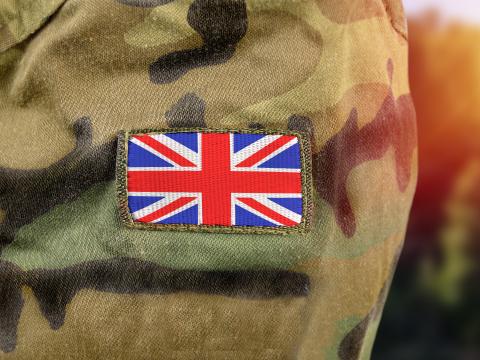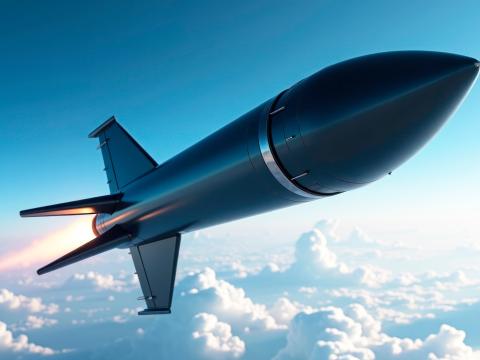Future Combat Systems Begin to Deploy
 |
 |
| The first spinout of hardware and software for the U.S. Army’s Future Combat Systems (FCS) is underway. The initial phase will integrate software radio systems and networking software into current Army vehicles such as Abrams battle tanks (t-l), Bradley fighting vehicles (t-r) and high mobility multipurpose wheeled vehicles (b). |
The first phase of the U.S. Army’s ambitious modernization program is preparing to enter service. The multi-billion dollar effort seeks to transform the Army into a network-centric force with advanced vehicles and precision weapons. Initial low-rate production and operational testing of selected equipment and software are underway after years of development and cost issues.
The goal of the Army’s Future Combat Systems (FCS) is to replace existing vehicles and weapons systems with a family of new lightweight multipurpose vehicles, sensors and weapons systems. FCS equipment and software will be issued to Army units in a series of increments called spinouts. Beginning in 2008, three spinouts will be launched in two-year increments. This new equipment will be issued to the Army Evaluation Task Force (AETF) in
FCS spinout 1 will provide the Army’s existing vehicle inventory with enhanced situational awareness and communications capabilities. High mobility multipurpose wheeled vehicles (HMMWVs), Abrams battle tanks and Bradley fighting vehicles are being fitted with network integration B kits consisting of an integrated computer system, the System-of-Systems Common Operating Environment (SOSCOE) and Battle Command and Network Management software. The new communications equipment will be the Joint Tactical Radio System Ground Mobile Radio (JTRS GMR) (SIGNAL Magazine, July 2007). Spinout 1 also includes tactical and urban unattended ground sensors (UGS) designed to provide warfighters with added situational awareness and the Non-Line-of-Sight Launch System (NLOS) for remote control precision artillery fire.
The first spinout 1 equipped vehicles are now undergoing trials at the Aberdeen Proving Ground in Maryland and at Fort Huachuca, Arizona, relates Col. Raymond D. Jones (USA), project manager for Modular Brigade Enhancements, Program Executive Officer for Ground Combat Systems, Warren, Michigan. The colonel says that hardware integration is taking place at the same time as the software installation from Boeing, the lead systems integrator for the current force. The new software includes the Battle Command software designed to support the FCS mobile network. Spinout 1 recently passed a critical design review, allowing the equipment to begin integration to active units and the AETF. The low-rate initial production goals for spinout 1 will support the procurement of equipment and software for 17 brigade combat teams that will be fielded incrementally over a seven-year period beginning in the 2008 fiscal year.
Col. Jones is sanguine about the effort’s progress. “We are where we said we would be in terms of schedule,” he says. Although challenges always exist in meeting complex defense program timetables, he notes that occasional difficulties are not unexpected. But he emphasizes that real hardware and software are now being integrated into Army units.
According to Charles Williams, head of special activities and FCS special projects program manager, Boeing Company, Houston, the B kits provide the Army’s current fleet of vehicles with both a network capability and a transport layer. He adds that the network transportation layer also acquires signals from the tactical and urban UGS systems. The UGS’ are in their final test stages before they enter field service. Another part of this work is linking the UGS to the network’s gateways and understanding how these systems interoperate. Operational testing for the UGS and the network transportation layer will occur in November at
The missile for the NLOS is currently undergoing developmental testing by the contractor. Known as the precision attack munition, the missile is fired out of a container launch unit (CLU). An FCS carrier vehicle is equipped with a CLU containing 16 missiles. Williams shares that the entire system is undergoing safety certification before it is issued to troops.
Another important component of the B kits is the JTRS GMR that is being installed in the vehicles. Col. Jones explains that the JTRS GMRs will provide brigade commanders with added communications capabilities. “We’re taking out two SINCGARS [single channel ground and airborne radio system] channels, and we’re putting in two SINCGARS, an EPLRS [enhanced position location reporting system] and a soldier radio wave form. We’re enhancing the networking capability for those leaders as well as providing situational awareness. This is a significant step forward in developing the FCS network into the Army,” he says.
Col. Jones adds that the B kits are the first increment of the full FCS system. He maintains that spinout 1 demonstrates that the program is delivering field-capable hardware and software. “If you go two steps outside the program, it’s hard for people to understand the program. It’s been in a cerebral mode for so long, but we are now actually producing it. We are going to get hardware to the soldier. This is real stuff,” he maintains.
The B kits are designed to provide existing vehicles with network-centric capabilities. An important component of the kits is SOSCOE, which serves as middleware and enables the network’s various hardware and software components to communicate. But the key software application is the Battle Command system. Williams says that after the current limited user test (LUT), the Battle Command software will undergo a classified verification test portion, known as the Build 2 final. The Build 1 final is underway, and its components are now operating inside the spinout 1 systems. Build 1 equipment consists of the network systems management edition of the Battle Command software, the Level 1 fusion system and a sensor data manager.
The Battle Command software consists of 10 basic subsystems that interface with each other. For example, raw data coming in from a UGS is transmitted via short wave radio back to a vehicle’s computer. The computer conducts the Level 1 fusion by processing the data for operationally relevant information and identifying and classifying targets. This data is then displayed on solders’ computer screens.
System integration also extends to the software operating the vehicles. A part of the Battle Command software known as the Platform Integration Manager will communicate and interface with a vehicle’s computer system and its B kit. This capability allows soldiers and vehicle commanders to turn the vehicle on or off, as well as operates parts of the JTRS GMR communications system. However, this interface portion must be tested and approved during the software safety release process. “The primary concern with the Bradley and the Abrams [platforms] is that the software and the interfaces are so well controlled and known that we won’t have an uncommanded turret movement or vehicle response that will wind up hurting a soldier,” says Williams.
However, the B kits installed on HMMWVs do not interface with any part of the vehicle. The software will interface only with the Force 21 Battle Command Brigade and Below (FBCB2) systems already installed in most Army HMMWVs.
The Platform-Soldier Mission Readiness System (PSMRS) application will allow commanders to determine the status of a system. But Williams cautions that it is key for all of the individual subsystems to be attached to PSMRS. He notes that B kits will be provided only to unit commanders from platoon leaders up to brigade command staff. PSMRS will permit commanders to determine a vehicle’s maintenance status and its overall well-being.
In March 2008, FCS spinout 1 systems will undergo technical field tests, and another portion of the LUT will follow in July. The U.S. Army Training and Doctrine Command also will test the software at White Sands. Williams explains that the software’s maturity is at the point where it is being tested to detect and correct faults, then it is being returned to the software and vehicle systems integrators. He says that this is the same developmental process used for any software going into all aircraft or ground vehicles.
This same rigorous test process is being applied to the UGS systems. A surrogate radio currently is being used in the UGS because the small factor JTRS system is not yet available. The final UGS radios will be JTRS small form factor radios. To meet immediate needs, the program decision makers chose a multichannel software radio in a small form factor to fit in the sensors.
There are two types of UGS sensors: tactical and urban. The tactical devices are equipped with an infrared imaging system and sensors to detect ground movement from vibrations. The sensors also will provide commanders with pictures of detected troops or vehicles. In addition, the sensors detect radiological and nuclear emissions from an attack or accident. The urban UGS capability features an infrared sensor and motion detection capabilities. Urban UGS will be left behind in buildings or tunnels to prevent enemy forces from re-infiltrating cleared areas.
A major goal of the unattended battlefield sensors part of FCS is to provide troops with enhanced situational awareness. For example, the commander of a reconnaissance platoon that has been ordered to protect a road or a checkpoint at night can deploy the UGS around corners or bends in roads up to 1.5 kilometers (0.9 miles) from the soldiers’ position. Williams notes that advanced warning is safer than posting soldiers in vulnerable positions at night. The sensors also provide soldiers with critical time to detect and react to threats, he says.
FCS provides the Army with two main functions, the colonel explains. The first is to field an enhanced capability to the current force via UGS sensors, the integrated computer system, the Battle Command and PSMRS software sets. The second benefit is that spinout 1 provides risk reduction for the core FCS program. “We’re getting things out there early so that we can inform the core FCS program about how this stuff really works, so that we don’t wait 10 years or whenever the first fielding is and figure it out then. By the time the FCS starts fielding its first brigades, the risk to that program will be significantly less because we will have learned from the things that we’re putting out there now,” he offers.
Col. Jones explains that for the first time, the current force combat vehicles are having their systems integrated into them as part of a greater network, not an appliqué solution. “Our goal here is not just to slap a new box on the side but to start to integrate this stuff as you would in an aircraft—in an advanced system. We really are making a significant leap for ground combat vehicles. These are becoming complex integrated systems, not the tanks of our fathers,” he says.
The AETF timetable calls for safety released, mission ready B kit equipped vehicles to be ready for operations early in 2008. LUTs are scheduled for July or August 2008, and a milestone C for spinout 1 will occur in January 2009. The classified verification tests will follow this milestone. An initial operational test and evaluation are set for the late summer and early fall of 2010, and then fielding to the Army will occur. Technical field tests for the equipment will begin in March 2008, which will move up to the LUTs in July and August of that year.
Web Resources
Program Executive Office, Ground Combat Systems: www.peogcs.army.mil
Boeing Company: www.boeing.com



Comments